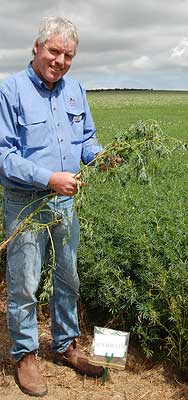Western Australia
November 5, 2008
Source:
GRDC's The Crop Doctor
Narrow-leafed lupins are a very
important grain legume crop in Australia, with WA growers
producing 85 per cent of the world’s lupin crop.
 |
|
Alan
Meldrum, Pulse Development Officer, WA, for the GRDC
supported Pulse Australia, with narrow-leafed lupin
Jenabillup , bred for the south and south-east coastal
zones of WA. |
They are a vital component of sustainable farming systems in
WA’s Mediterranean climate and have value as a break crop for
weeds and diseases of cereals, particularly wheat.
Narrow-leafed lupins also add value to the nitrogen economy of
farming systems and, with rising fertiliser costs, are expected
to have an increasing value.
Yet in the past 10 years grower confidence in narrow-leafed
lupins have decreased due to low and variable yields and low
value on international markets.
According to Dr Jairo Palta of CSIRO Plant Industry WA,
misconceptions among researchers, consultants and growers about
the growth and yield of narrow-leafed lupins have discouraged
adoption.
He wants to set the record straight by separating myth from
reality, so growers will have confidence to give lupins a try,
particularly in ‘new areas’ such as high rainfall areas of
southern WA.
Speaking at the Grains Research and Development Corporation
supported 12th International Lupin Conference in Fremantle, WA,
Dr Palta said one such myth is that when soil water and
nutrients are abundant, narrow-leafed lupin will grow and
accumulate biomass endlessly, without converting this to seed
yield.
Another popular myth is that restricting growth and biomass
accumulation in the apical branches (branches other than the
main stem) leads to higher seed yields.
Investigation shows both myths need busting.
Evaluating a breeder’s core collection under abundant soil water
and nutrients in WA showed indeterminate growth ceased,
regardless of water and nutrient availability.
Analysing growth and yield on the main stem and apical branches
showed total seed yield positively correlates to apical branch
biomass, rather than main stem biomass alone.
Another finding was that productivity in narrow-leafed lupin is
source, rather than sink limited, meaning the crop has little
capacity to store and redirect reserves to the seed during grain
filling.
Increasing the number of pods by applying the hormone cytokinin
did not increase yield, as many pods failed to fill their seed.
Dr Palta indicated this was due to the plant’s limited ability
to accumulate carbon in vegetative parts for remobilisation in
the developing grain.
Escaping terminal drought is one characteristic of modern
narrow-leafed lupins, but finishing the growing season early
limits the time available for biomass accumulation, generating
tension between drought escape and maximising source potential.
Reducing biomass and metabolic activity can therefore markedly
decrease yield.
The Crop Doctor is GRDC Managing Director, Peter Reading |
|
|
|
 |
|
The Crop Doctor is
GRDC Managing Director,
Peter Reading |
|
|